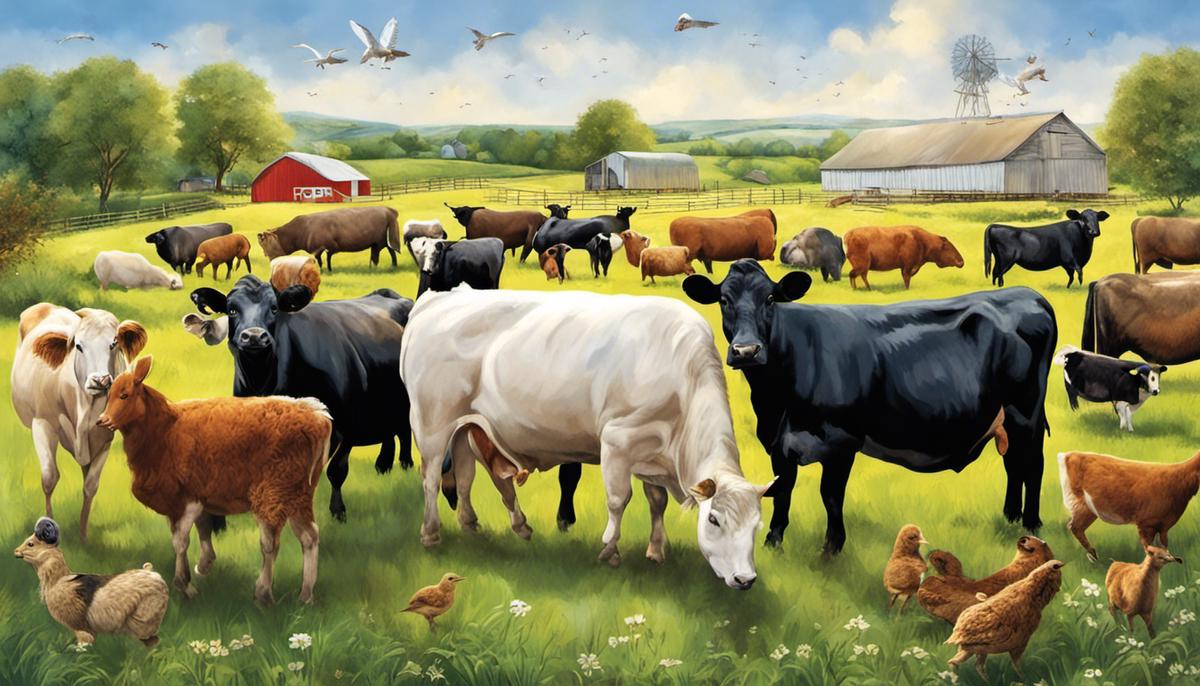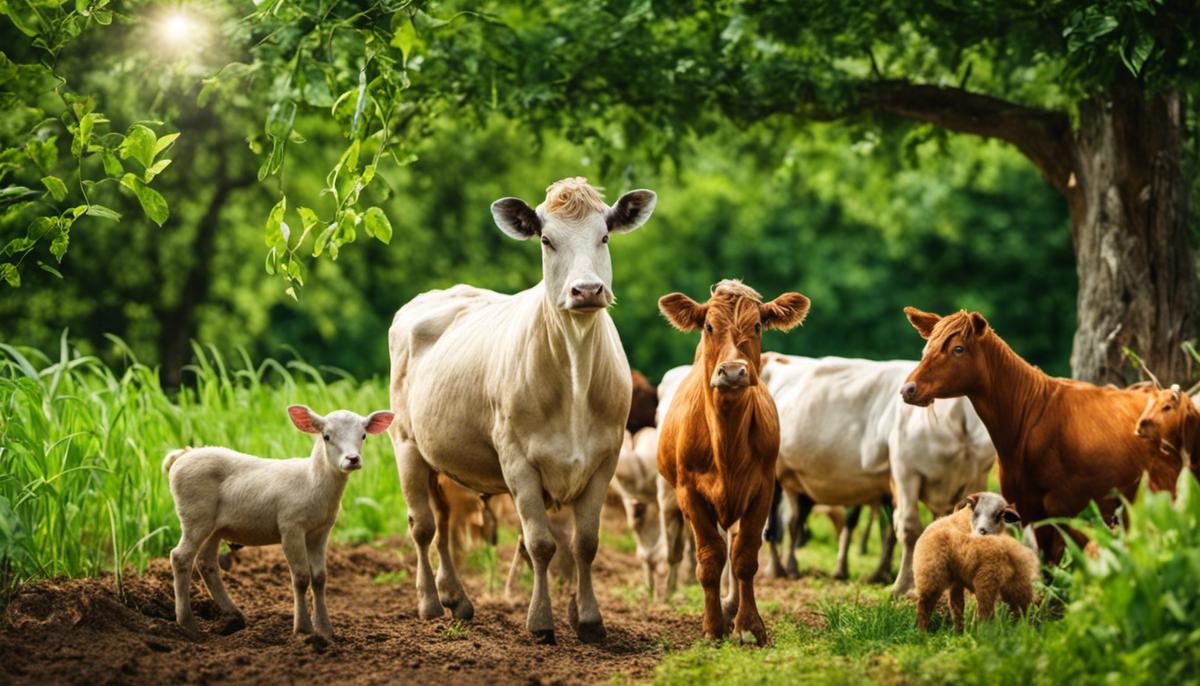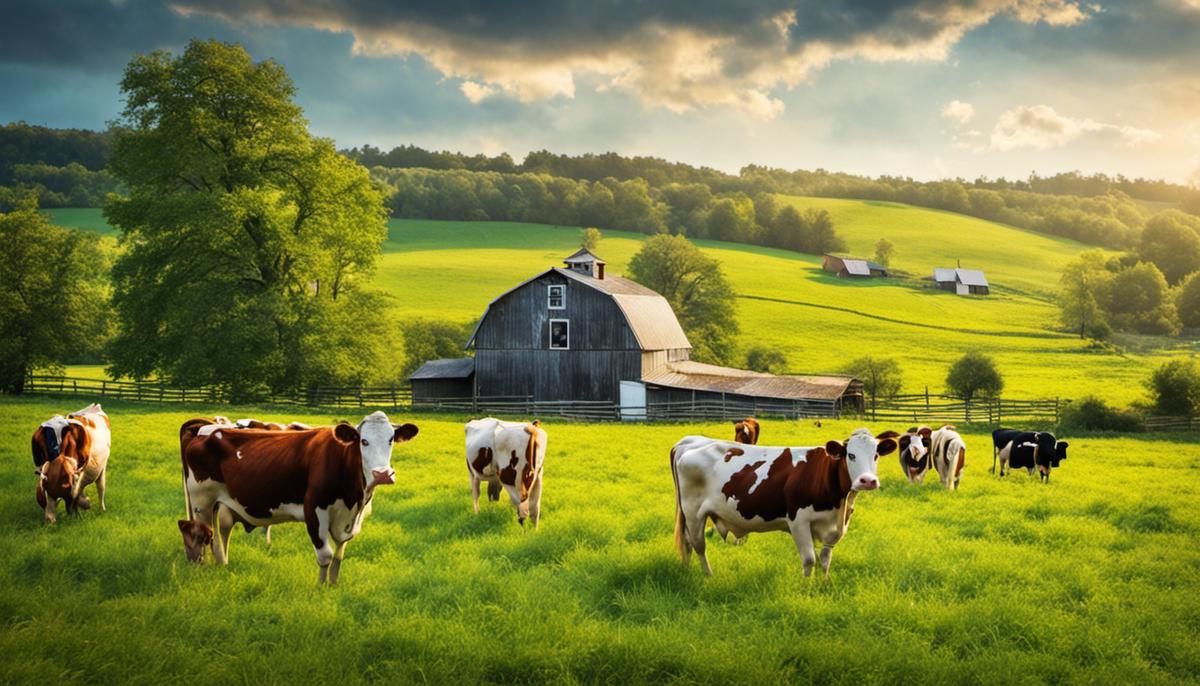
Animal farming
Description: Animal farming represents a critical intersection between science, technology, ethics, environment, and society. The biological framework of each animal, dictating its growth patterns, diet, genetics and breeding nuances sets the underpinning for farm productivity and quality of produce. Cutting-edge technologies not only streamline the farming process but continuously transform its landscape with advancements in automation, AI or biotechnology. Moreover, as the industry progresses, it has become a moral imperative to ensure adequate animal welfare, enforce established laws, and spotlight their indelible link with the quality of farm products. Beyond the farm, the echoing impacts of animal farming on environmental sustainability and climate change cannot be understated, with its significant contribution to greenhouse gas emissions and resource depletion. Furthermore, animal farming's economic and social implications ripple across the livelihoods of rural communities, food security, and polarized debates regarding mass-production and ethical consumption. The fascinating realm of animal farming is grounded in an intricate biological framework that harmonizes a multitude of different components in a bid to ensure efficient and sustainable production. As we delve deeper into this fascinating topic, we will illuminate the key aspects that delineate this remarkable sphere of productivity. At the core of the framework is the understanding of animal physiology, which provides a blueprint for the management of an array of facets from feeding to breeding. Animal physiology informs us about the dietary needs, growth optimization strategies, and overall health maintenance requirements of different livestock species. Thus, furnishing key insights into the formulation of nutritive feed, development of growth-promoting strategies, and prevention and control of diseases. Continuing in this cogent vein, genetics play a significantly pivotal role within this biological framework. Selective breeding depends heavily on the comprehension of genetic principles, leveraging the manipulation of animal genetic makeup to enhance desirable traits such as high growth rate, disease resistance, or enhanced milk production. Advances in genetic engineering technology now permit even more precise manipulation providing unprecedented opportunities for the improvement of livestock species. Reproductive biology constitutes another fundamental facet of this framework, where understanding the reproductive cycle, mating behavior, and embryo development of farm animals surfaces as critical. Consequently, it empowers optimized breeding strategies, timely detection of pregnancy, and prevention of birthing complications, all of which significantly impact overall productivity and farm operations. Coupled with this, we turn our attention to the enthralling sphere of animal ethology, the study of animal behavior. An understanding of animal behavior aids in predicting and managing an animal’s interaction with its environment and other farm animals. For instance, knowing the social hierarchies within a flock or herd can guide the forming of groups that minimize stress and keep peace, thus promoting animal well-being and productivity. Last, yet by no means least, the biological framework incorporates the study of livestock-environment interactions. This encompasses the study of the impact of different environmental factors such as temperature, sunlight, or noise levels on the physiological and psychological well-being of the livestock as well as how farming practices affect the environment. Inextricably woven together, these diverse strands of biological sciences create the rich tapestry of animal farming, informing best management practices that sync harmoniously with the animals' biological rhythms and needs. Embracing this comprehensive biological framework inevitably leads to the realization that the science of animal farming is a captivating symphony of evolutionary, genetic, physiologic, and environmental factors playing in concert. The transformative power of technology has not left animal farming untouched. On the contrary, it has profoundly changed farming practices and holds tremendous potential for the future. Digitalization and automation have ushered in increased efficiency and productivity in animal farming. Precision livestock farming (PLF), for instance, utilizes modern technological tools to continually monitor and manage livestock. In this approach, sensors and software are used to measure a range of parameters, from animals' feed intake and weight gain to health status. This real-time data allows farmers to make informed, proactive decisions that enhance animal welfare, improve productivity, and reduce environmental impact. Artificial Intelligence (AI) is another disruptive technology shaping animal farming. Highly sophisticated algorithms can now predict various outcomes including disease outbreak, yield, and even the ideal date for livestock reproduction. This predictive capacity considerably enhances farm management and decreases the likelihood of adverse events, illnesses, and unanticipated losses. Drone technology, though traditionally associated with crop farming, shows great promise in animal agriculture. Drones are being deployed for surveillance tasks, identifying sick or injured livestock amidst large herds, or monitoring feeding behavior. This not only saves farmers precious time but also assures a higher level of welfare for the animals. The symbiotic relationship between technology and genetics extends beyond selective breeding and their integration is also remapping the contours of animal farming. Techniques like genome editing, once confined to lab-based research, are now being harnessed in practical farming contexts. Such genetic engineering offers unprecedented potential for disease resistance and optimization of livestock traits. However, these advances also bring bioethical considerations to the fore and demand thorough regulatory scrutiny. Lastly, with technological advances comes the inevitable digital vulnerability. Cybersecurity is therefore a pressing concern in high-tech animal farms. Infrastructure must be progressively equipped to handle potential threats and safeguard vital data. Looking forward, tremendous potential lies within futuristic technology such as nanotechnology and robotics. Nanotechnology, with its potential to manipulate molecules and atoms, could revolutionize areas such as animal health, disease diagnosis, and treatment, feed optimization, and waste management. Concurrently, robotics could undertake laborious manual tasks, securing not only efficiency but also reducing risks to human workers, as well as minimizing stress for the animals. Combining these technological trends with ongoing research in animal physiology, genetics, blue biotechnology (aquaculture), and animal welfare augur a dynamic and transformative future for animal farming, capable of meeting the impending food demands of a growing global population. As a rule, however, it is essential to balance this progressive march with ethical, environmental, and sustainability considerations to ensure an all-encompassing evolution of animal farming. Relocating from the discussion of technological aspects and genetic considerations, this article decisively ventures further into the topic of animal welfare within farming, touching on crucial aspects that influence the welfare of the animals in the farming industry. The topics of focus include diet and nutrition management, provision of necessary medical treatment, and biosecurity, and the business sustainability of such endeavors. The critical aspect of diet and nutrition management cannot be stressed enough. Just as the human body requires a balanced diet for optimal functioning, animals reared in farming facilities require a diet tailored to their specific needs to maintain their physical health and well-being. Providing adequate essential nutrients and balanced diets for livestock promotes healthy growth, improves productivity, and reduces the incidence of diseases. Moreover, an often-overlooked aspect of animal welfare revolves around disease prevention and treatment. Disease management extends beyond just the vaccination of livestock. Proactive strategies, like monitoring the health status of animals in real-time and promptly providing necessary medical treatments, play a pivotal role in the overall welfare of the animals and subsequently the quality of products obtained. Biosecurity measures also hold substantial weight in maintaining animal welfare. These measures comprise processes and practices designed to prevent the introduction and spread of diseases into a farm. Ensuring proper sanitation, routine cleaning and disinfection, independent housing for ill animals, proper disposal of dead animals and waste, can drastically reduce disease risks enhancing animal welfare. Incorporating such welfare-enhancing modifications may present a complex financial challenge for many farmers, particularly small-scale ones. Business sustainability, therefore, becomes an essential consideration in actualizing the optimal welfare practices. Adopting sustainable business models that integrate welfare-oriented practices can help drive innovation, efficiency, and productivity on farms. Upgrading farming infrastructure with an aim to improve animal welfare may require significant investment. However, in the long run, these investments could lead to increased productivity, reduced loss due to disease, and enhanced product quality, ultimately benefiting both the animals and the farmers. In the valiant pursuit of optimizing animal welfare within farming, it is pivotal to acknowledge the crucial role of agricultural policies and legislation. Policies must reflect the evolution of scientific knowledge and societal values regarding animal welfare. Undoubtedly, animal welfare is a complex and multi-faceted area that requires coordination between various aspects of farming, from feeding to healthcare management to technology adaptation. It wraps up the vernacular wisdom of traditional farming techniques while engaging with the monumental scientific advancement in a harmonious symphony. Areas covered earlier such as animal physiology, ethology, livestock-environment interactions, and the integration of technology have immense potential in framing the future of animal farming, a future that accommodates advancements while preserving the very cornerstone of farming – the welfare of animals. And while the narrative of animal welfare in farming continues to unfold, there remains an unwavering commitment to researching, understanding and improving the lives of animals in agricultural systems. However, the mitigation of these impacts begins by addressing how we can develop sustainable animal farming, a multi-faceted solution that requires a unified approach from all stakeholders, ranging from scientists, farmers, policy-makers to consumers. Advancements in agricultural science present opportunities towards carbon reduction, primarily through methane capture technology. Methane, a potent greenhouse gas produced by ruminant livestock, can be captured and converted into energy, potentially transforming a harmful emission into a useful resource. Manure management strategies can also significantly mitigate methane emissions, through techniques such as covered lagoon digesters and composting. Furthermore, sustainable feed innovations are making strides. Among them is the cultivation of insect-based feeds, which have lower emission footprints and less reliance on land and water resources compared to traditional feedstuffs. Similarly, the scientific community is also exploring seaweed-based diets that could dramatically reduce methane production in livestock. Efficient water management techniques, like precision irrigation, can curtail water wastage. It allows farmers to provide the exact amount of water needed by crops, thereby reducing the overall water footprint of animal farming. Another area of major consideration is the use of land. Improved pasture management techniques can enhance the carrying capacity of land, enabling more animals to be reared on less space, therefore reducing deforestation. Integrating agroforestry into animal farming systems can also contribute to carbon sequestration while providing supplementary feed for livestock. Consumers play an essential role in this transformation towards sustainable animal farming. Growing demand for sustainably reared meat could drive changes within the industry. Technological awakenings, such as blockchain technology, can improve traceability in the food chain, enabling consumers to make more informed choices about their food sources. While technology has brought a profound transformation of animal farming practices, there continues to be an ongoing discussion about the environmental, ethical, and sustainability considerations that come with it. Discussions around the balance between animal welfare and the need for efficient production have led to a broad spectrum of viewpoints, highlighting the complexity of achieving sustainable animal farming. In conclusion, the contemporary landscape of animal farming calls for continual research, innovation, a multidimensional approach and an appreciation of the complex relationship between animal farming and the environment. Navigating the transition towards sustainable animal farming will necessitate a deep commitment to balancing economic, environmental, and ethical considerations to ensure the well-being of not only the animals but of the entire ecosystem. Animal farming indisputably holds a central role in today's economic and social landscape. Recognized as the backbone of human nutrition, this significant industry not only sustains millions worldwide but also provides jobs and direct economic advantages to numerous communities. However, animal farming’s broader implications encompass more than the simple production of food. Through an economic lens, animal farming contributes extensively to economies both large and small. Livestock accounts for an estimated 40.5% of the global value of agricultural output and provides livelihood for 1.3 billion people. Animal farming functions as a robust economic stimulus, offering jobs in direct production and ancillary industries such as processing, marketing, distribution and veterinary services. Market dynamics, mechanisms, and international trade policies often dictate the economic profitability and sustainability of these farming systems, functioning as crucial facets of a country's financial growth. Nonetheless, to examine the benefits of animal farming without acknowledging their social implications would be remiss. A multifaceted social fabric is inherently woven into animal farming, from the rural families whose livelihoods depend on it, to urban denizens who appreciate access to diverse protein sources. This farming entertainment integral lessons of economics, business management, animal care, nutrition and resource management to farming communities and their children. Additionally, animal farms often support local businesses and contribute to communal identity, shaping the socio-cultural structure of towns and regions. Apart from its economic and social benefits, it is also critical to examine unfortunate negative impacts of animal farming. Needless to say, these are not to belittle the importance of this industry, but to promote refinement and more humane, sustainable practices. Communities located in close proximity to large industrial farms often face adverse effects due to odorous nuisances, noise pollution and potential decreases in property values. In many areas, the economic and social benefits are offset by the potential risks to public health from the improper management of animal waste and the extensive use of antibiotics in livestock. From a wider perspective, it is critical to consider the longer-term implications of animal farming on food security. The efficient management of our natural resources while maximizing animal farming output is imperative to meet the growing demand for protein amidst a rapidly expanding global population. As such, animal farming's role in maintaining food security and sovereignty for nations is a prime consideration. Undoubtedly, animal farming’s far-reaching implications resonate into many aspects of human life and the environment. It urges us to pursue knowledge, refinement and innovation in how we practice animal farming. Though issues persist, it should not deter us from our endeavor to unleash the potential for a sustainable and prosperous future through animal farming. Advancements in scientific research and technology hold promise for mitigating many of these concerns, paving the way for a productive and enriching future in this pivotal industry. Fundamentally, the animal farming landscape presents a complex tapestry woven with intricate biological processes, rapidly progressing technology, ethical considerations, environmental consequences, and socio-economic implications. Rationally navigating this landscape demands a thorough understanding of each species, its biology, growth patterns, and diet compiled with the utilization of updated farming technologies. Animal welfare must remain central to this narrative, staying aware of established laws and understanding their correlation with produce quality. Factoring the far-reaching environmental impact of animal farming is equally crucial, including its link with greenhouse gas emissions and resource strain. Lastly, it is imperative to not lose sight of the broader socio-economic impact of this industry, appreciating its role in rural economies, food security, and differentiating between mass-production and ethical consumption paradigms.The Biological Framework of Animal Farming
Unraveling the Biological Framework Underlying Animal Farming

Technological Advancements in Animal Farming
The Era of Technology in Animal Farming: A Glimpse into The Present and Futuristic Predictions

Animal Welfare in Farming

Environmental Impact of Animal Farming
The environmental footprint of animal farming significantly impacts the global ecosystem in manifold ways, from climate change to deforestation to water pollution. According to scientific literature, animal farming is responsible for nearly 14.5% of global greenhouse gas emissions, a contributing factor to the ongoing climate crisis. Additionally, the sector plays a considerable role in deforestation, as land is cleared to cultivate crops for livestock feed, and the overutilization of water resources for both livestock consumption and crop irrigation.

Economic and Social Implications of Animal Farming
